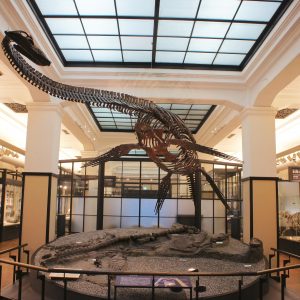Browsing the "Paleozoic" Category
The Paleozoic era, meaning “ancient life”, is a division of earth’s history spanning from around 541 to 252 million years ago. It is subdivided into the Cambrian, Ordovician, Silurian, Devonian, Carboniferous and Permian periods. The beginning of the Paleozoic is characterised by the sudden appearance of animal ecosystems following the extinction of the Precambrian Ediacaran fauna. The end of the Paleozoic is marked by the greatest mass extinction in earth’s history, following which global ecosystems were radically reorganised.

Published on August 1st, 2017 | by Caitlin Colleary
The transition of fins to limbs is one of the most significant in the history of vertebrate evolution. These were the first steps that would eventually allow tetrapods to go on to dominate so many terrestrial [&hellip... Read More →

Published on June 30th, 2017 | by Liz Martin-Silverstone
When thinking of palaeontology in Asia, most people think of Mongolia and China, but there is actually a significant palaeontology community in Japan. Japan has many fossils, starting in the Ordovician, and ranging from everything from [&hellip... Read More →

Published on February 20th, 2017 | by David Marshall
Tullimonstrum gregarium, the ‘Tully Monster’, is an enigmatic fossil from the Late Carboniferous Mazon Creek lagerstätte, Illinois, USA. This soft-bodied animal is instantly recognisable by its ‘torpedo-shaped’ body ending in a tail; its long, elbowed, proboscis [&hellip... Read More →

Published on February 6th, 2017 | by Guest Blogger
Molluscs are among the most disparate of the animal phyla. They range from the incredibly complex squids and octopods, which have acute vision and can even be intelligent enough to use tools, to very simple and [&hellip... Read More →

Published on October 15th, 2016 | by Laura Soul
Graptolites are small colonial organisms, each made up of many tiny, genetically identical zooids joined together by tubes. They’ve been around since the Cambrian and at times in Earth’s history have been very morphologically and taxonomically [&hellip... Read More →

Published on August 15th, 2016 | by David Marshall
Plants, Animals and fungi; these are all three of the Kingdoms of life we’re all most familiar with, but what you might not know is that fungi are more closely related to animals than they are [&hellip... Read More →

Published on July 22nd, 2016 | by Liz Martin-Silverstone
Blue Beach is a locality in Nova Scotia, Canada that is well known for it’s fossils from the Lower Carboniferous. In particular, it is significant for being one of few sites in the world that has [&hellip... Read More →

Published on May 29th, 2016 | by David Marshall
Around 250 million years ago, the largest biotic crisis the world has ever known occurred. The Permo-Triassic Mass Extinction (PTME) was an event that saw the loss of up to 95% of all species. The extinction [&hellip... Read More →

Published on April 13th, 2016 | by David Marshall
Science is a process and so the door to the revision and refinement of hypotheses must always be left open. From the research discussed in our last episode, the newspapers would have you believe that the [&hellip... Read More →

Published on March 18th, 2016 | by David Marshall
Tullimonstrum gregarium, better known as the ‘Tully Monster’ is a problematic fossil from the Late Carboniferous Mazon Creek lagerstätte, Illinois, USA. The identity of this fossil has been the subject of much debate, due to its peculiar [&hellip... Read More →























